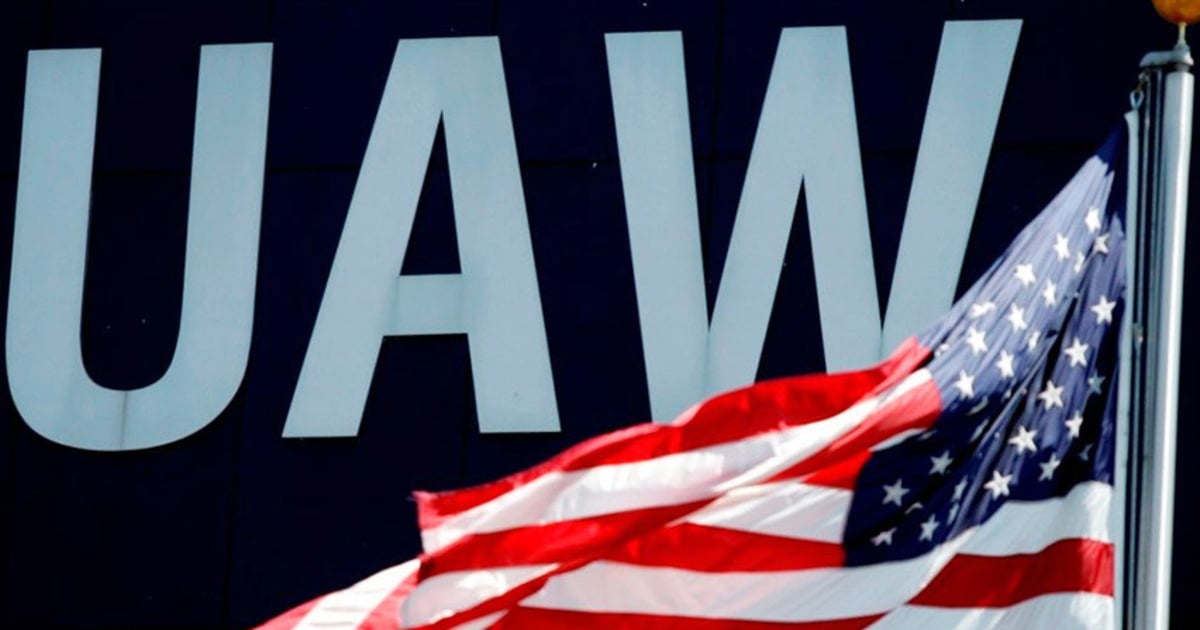
UAW leaders are laying the groundwork for what they believe could be a powerful weapon in this year’s contract talks with the Detroit 3: an engaged, informed membership.
President Shawn Fain, joined by Secretary-Treasurer Margaret Mock and the three vice presidents who will lead bargaining this fall, held a virtual town hall last week — a first for the UAW — to lay out their priorities directly to members. Fain in recent weeks also has engaged the rank and file via livestreams on Facebook, and the union has been increasingly active with informational posts on its website and social media.
Fain has argued that waging what’s known as a contract campaign — coordinating the union’s messaging from the bottom up to build pressure on the automakers — is necessary to successfully negotiate. His openness aims to break from the struggles of previous leadership to connect with the mood on the factory floor and to restore members’ trust after the corruption scandal that came to light in 2017 and sent two ex-presidents and other former officials to prison.
“We’re going to do things differently this round of negotiations,” Fain said at the nearly half-hour town hall. “This fight’s not going to be won by [leadership]. This fight’s going to be won because our members are informed, our members are organized, and they’re united.”
The union’s list of demands is lengthy. After years of what were viewed as concessionary contracts, the UAW wants to end the tiered pay system, reinstate cost-of-living increases, add stronger job protections to prevent plant closures and ensure new electric vehicle joint ventures employ union labor at top wages.
Union leaders used the town hall to argue that Ford Motor Co., General Motors and Stellantis have more than enough money to meet such requests. All three contracts, which were signed in 2019 after a 40-day strike against GM, expire in September.
“They can afford our demands, and we expect them to pony up,” Fain said.
“This is our time to get our fair share of the pie.”
The leaders struck a defiant tone at times, using charts and graphics to contrast abundant corporate profits with stagnant union wages. Fain said the Detroit 3 had, over the past decade, made a quarter of a trillion dollars — “that’s trillion with a ‘T,’ as in, ‘time to pay up’ ” — or enough to have collectively purchased every pro baseball, basketball and hockey team and still have billions left over.
Vice President Rich Boyer, head of the Stellantis department, criticized CEOs Mary Barra of GM, Jim Farley of Ford and Carlos Tavares of Stellantis for their high compensation relative to the average worker’s wages.
“Remember that when they say we’re family,” Boyer said. “We’re not family.”
Marick Masters, a business professor at Wayne State University in Detroit who specializes in labor issues, said the union’s intentions are clear.
“It’s a full-court press to utilize social media to communicate broadly to the membership to get them prepared to engage,” he said. “It makes the threat of a strike much more viable.”
Mock last week said the union wasn’t afraid of the possibility of a walkout, noting that the 2019 strike cost GM $3 billion.
“The choice of whether or not we go on strike is up to the Big 3,” Mock said. “The companies know what our members deserve, and they can afford to give it to us. They can work with us to make sure we get what we are owed, or they can fight us, and we will be forced to take action.”
The union has about $825 million in its strike fund, Mock said. Its executive board in February raised strike pay 25 percent to $500 per week.
“A strike can be costly, so that’s something you want to be pretty transparent about,” said Art Wheaton, a labor expert at Cornell University. “The members will have to prepare their wallets and their own personal budgets.”
While the union often talks tough ahead of contract talks, Fain and his team have deployed particularly divisive language since being elected over two rounds of voting last fall and winter. In his first address to members at the UAW’s bargaining convention in March, Fain called multibillion-dollar corporations such as the Detroit 3 the union’s “one true enemy” and has said this year’s negotiations will be the “defining moment” for this generation of workers.
“I think it’s to gin up the base,” Masters said. “They want the companies to know the concessionary tone of the past is over.”
Fain’s proclivity for engagement also stems from the union’s recent history.
Former Presidents Dennis Williams and Gary Jones were among a dozen UAW officials who were convicted of stealing money from members. The scandal raised questions about the integrity of those involved in negotiating each of the union’s past three contracts.
Fain wants to prove those days are in the past.
“They’re trying to go above and beyond previous attempts to be transparent,” Wheaton said.
“I think they’re trying to reduce any appearance of having a conflict. The previous administrations had some issues with past negotiations and whether or not they were actually representing members’ needs.”
Another factor, experts say, is Fain’s narrow victory in the union’s first direct election of officers. He won the presidency over incumbent Ray Curry by fewer than 500 votes and received the support of less than 7 percent of the UAW’s membership.
Unlike past leaders, Fain will be directly answerable to members in the next election, in 2026, adding pressure for him to show that he has their interests at heart.
“He’s been pretty open and flexible to talk,” Wheaton said. “Everyone should be able to say they had opportunity to provide feedback, so they’re more likely to get buy-in.”

